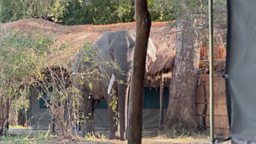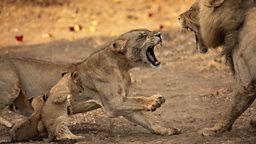Large carnivore dynamics
Africa’s big cats, hyenas, and wild dogs have evolved elaborate strategies to compete and coexist, but new studies indicate that human impacts may be rapidly unravelling them.
By Matt Becker - CEO at the Zambian Carnivore Programme

Large carnivores have long captivated and inspired the public imagination, particularly the big cats, wild dogs, and hyenas of savannah Africa. Interestingly, the vast majority of carnivores worldwide are solitary, only found in groups when a mother is raising young or mating. But in Africa we have the most social species of the cat family (the lion), of the dog family (wild dogs, even more than wolves), and of the hyena family (the spotted hyena), all occurring in the same areas and interacting heavily. These species have the most complex and contrasting social systems as well, with lions being male-dominated, hyenas female-dominated, and wild dogs with an alpha pair. Is all this complexity coincidence? Unlikely.
The lion is by far the dominant competitor
Forged through competition
All species have evolved with competition, and the five species of large African carnivore—the lion, spotted hyena (hereafter hyena), wild dog, leopard, and cheetah—are perfect examples of this evolution. These species form a guild: a group of species with similar ecological requirements. Virtually everything about them, from how they look to what they eat, their vocalisations, movements, activity patterns, and breeding systems, are shaped by competition. Although they compete, these interactions are far from equal.
The lion is by far the dominant competitor and, together with the hyena, have significant impacts on their smaller-bodied subordinate wild dog, leopard, and cheetah competitors. Lions can, and regularly do, kill adults and young of all the other carnivore species and steal their kills. Similarly, hyenas can steal kills and, particularly with cubs and pups, predate these other species. And between lions and hyenas there is fierce competition. Avoiding getting killed or having your kills stolen are key needs for all the carnivores; such interactions and relationships shape virtually everything about these species’ ecology and behaviour.
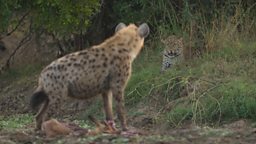
Coexistence strategies
Some food for thought: Why do wild dogs and cheetah calls sound like birds and are so quiet compared to lions and hyenas? Why don’t wild dogs and cheetahs typically scavenge carcasses? Why are they so unpredictable and wide-ranging in their movements? Why do leopards utilize trees so much? Why do cheetahs (and in the Luangwa, leopards) hunt in the heat of the day? The answers to these questions lie in the elaborate strategies these species have evolved over millions of years to successfully compete and coexist.
Why do wild dog and cheetah calls sound like birds and are so quiet compared to lions and hyenas?
Wild dogs and the evolution of cooperation
Wild dogs are an excellent example of such unique strategies. A subordinate competitor, wild dogs are naturally rare, occurring at orders of magnitude lower densities than their lion and hyena counterparts even in ecosystems where they are doing well. This is because dogs are naturally limited by lions (and to a lesser extent by hyenas), who regularly kill adults and pups and can steal kills. As a consequence, dogs are extremely mobile and unpredictable, covering 15 km/day on average, feeding primarily on small- to mid-sized antelope, and typically avoiding areas of high lion density.
Pack size is of utmost importance to dogs, as bigger packs are more successful hunters, exert less effort, make more multiple kills, and raise more pups. Since most dogs leave the pack they were born in at 2-3 years of age (after helping raise their younger brothers and sisters) and disperse in same-sex groups to form new packs, more pups means bigger dispersal groups and a greater chance of success. In addition, their quiet bird-like calls and tendency to not scavenge is linked to avoiding detection by lions and hyenas.

Human impacts on carnivore competition
In the conditions of the past, these strategies were very successful for wild dogs, as were the strategies of the other competitors they have shared the landscape with for the last 3.5 million years. But human impacts are rapidly altering ecosystems, and this is exerting severe impacts on these species. And what worked for 3.5 million years is now being changed in the last 35 years. Thus, the question is what are the consequences of altering these time-tested relationships between carnivores? Long-term intensive studies of these species by the and partners, featured in Kingdom, are beginning to shed light on these impacts and on the actions needed to address them.
...what worked for 3.5 million years is now being changed in the last 35 years.
The poaching of antelope and other species for the illegal bushmeat trade is resulting in severe impacts on carnivores. It reduces the capacity of the landscape to support them due to depleted prey, it kills and injures carnivores through snares (such as what happened to Flint), and it is altering these competitive relationships with subtle but profound impacts. In short, bushmeat poaching tends to focus on the larger species preferred by lions, forcing them to compete more with wild dogs, leopards, and cheetahs for smaller prey, thus resulting in smaller prides with fewer cubs.
For subordinate species such as wild dogs, they still must contend with the risk from lions, which can even increase with prey depletion, and this results in lower survival, fewer pups making it to yearlings, smaller packs and larger home ranges. The cause of these dynamics is simple and : packs must expend more energy, hunt longer and further, and are less successful. And ultimately these changes are severe enough that the currency of wild dog success—pack size—actually is no longer an advantage in the prey-depleted systems that characterize the species’ remaining range.
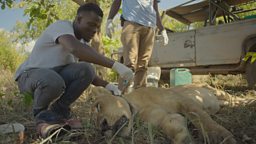
Long-term projects such as these, which can delve into the complexities of these species dynamics and address the impacts and threats facing them, are often viewed as a luxury compared to short-term, quick surveys that provide density estimates. Certainly, there is a cost to understanding and addressing the threats facing Africa’s large carnivores, but there is also a cost in not having this data, not understanding these dynamics, and not properly addressing these threats. Thus, the question is: Can we afford not to know?
...the question is, can we afford not to know?
More information on these studies can be found here:
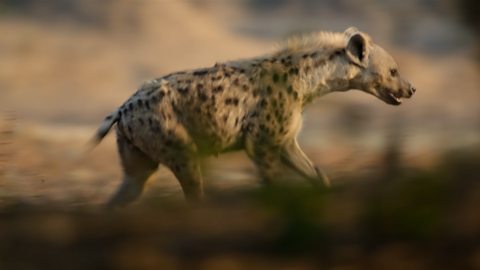
Pregnant hyena forced to take risks, saved by lion-sized distraction
Mother-to-be Tandala, escapes wild dogs thanks to a lion’s surprise distraction.

